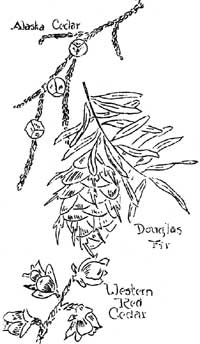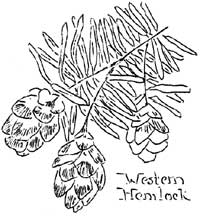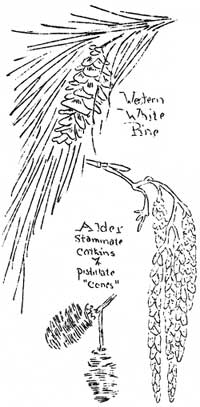TREES OF MT. RAINIER NAT'L PARK

 Probably the first feature of interest which catches the eye of the
visitor is the magnificent stand of timber that clothes the lower slopes
of "The Mountain". And no wonder! It is representative of the timber
of the Pacific Northwest, a region famed far and wide as the greatest
timber region in the world. Our trees are not of the greatest diameter,
nor do they claim the record in height but they strike a happy medium in
these two factors which is enhanced by a density of stand that is
probably unrivaled by any similar sized trees anywhere in the world.
Here we find great Douglas Firs, Hemlocks and Western Red Cedars up to
ten feet in diameter and in some cases over 250 feet tall, growing so
close together that their branches interlace far overhead to form an
evergreen canopy that serves as an almost impregnable barrier to even
the brightest sun's rays. For approximately two thirds of their height
these trees are clean and barren of limbs and in their symetrical form
one can easily visualize the stately pillars of some ancient temple.
Probably the first feature of interest which catches the eye of the
visitor is the magnificent stand of timber that clothes the lower slopes
of "The Mountain". And no wonder! It is representative of the timber
of the Pacific Northwest, a region famed far and wide as the greatest
timber region in the world. Our trees are not of the greatest diameter,
nor do they claim the record in height but they strike a happy medium in
these two factors which is enhanced by a density of stand that is
probably unrivaled by any similar sized trees anywhere in the world.
Here we find great Douglas Firs, Hemlocks and Western Red Cedars up to
ten feet in diameter and in some cases over 250 feet tall, growing so
close together that their branches interlace far overhead to form an
evergreen canopy that serves as an almost impregnable barrier to even
the brightest sun's rays. For approximately two thirds of their height
these trees are clean and barren of limbs and in their symetrical form
one can easily visualize the stately pillars of some ancient temple.
 The accompanying sketches illustrate the character of the cones which
serve as the principle means of identification. That of the Douglas
Fir, our best known species, is distinctive in that it has three
cornered bracts protruding from between the cone scales while the
Western Hemlock produces numerous, tiny cones about three quarters of an
inch long. The Western Red Cedar has a historic background. Its lumber
is straight grained and easily split so that the early settlers in this
region found it adapted to a variety of uses. The walls of their cabins
were of the logs of the cedar while shingles for their roof and puncheon
for their floors were split from this lumber. They were thus spared the
labor of hewing such material as the settlers in the eastern states were
forced to do during an earlier period in the history of our country.
However neither this tree nor the Alaska Cedar are true cedars. They
are known in botanical circles as Thuya plicata and Chamoecyparis
nootkatensis respectively. Here they answer to either their common or
scientific name and so you may take your choice.
The accompanying sketches illustrate the character of the cones which
serve as the principle means of identification. That of the Douglas
Fir, our best known species, is distinctive in that it has three
cornered bracts protruding from between the cone scales while the
Western Hemlock produces numerous, tiny cones about three quarters of an
inch long. The Western Red Cedar has a historic background. Its lumber
is straight grained and easily split so that the early settlers in this
region found it adapted to a variety of uses. The walls of their cabins
were of the logs of the cedar while shingles for their roof and puncheon
for their floors were split from this lumber. They were thus spared the
labor of hewing such material as the settlers in the eastern states were
forced to do during an earlier period in the history of our country.
However neither this tree nor the Alaska Cedar are true cedars. They
are known in botanical circles as Thuya plicata and Chamoecyparis
nootkatensis respectively. Here they answer to either their common or
scientific name and so you may take your choice.

Among the pines we have the Western White Pine, the Lodgepole Pine and
the White Barked Pine -- the latter being a very picturesque tree of the
rugged timberline regions. Here were often find it gnarled and twisted
by the unfavorable elements with which it wages a constant battle. Its
allies in this struggle are the Alpine Fir and the Mountain or Black
Hemlock -- which lend a picturesque touch to the high, sub-alpine parks,
including the justly famous Paradise Valley.
These are all cone bearing trees -- our forests here may be
considered as being almost wholly of that type. The "hardwoods" or
"broad leaved" trees -- that is those which lose their leaves in the
fall -- are of minor importance. There are only a few species of this
latter type here. Most important are the alder, cottonwood and maple
which lend a touch of bright green in the spring and a dash of autumnal
brilliance in the fall. As a matter of fact there are but twenty
species of trees in the Park -- and yet it is regarded as being
representative of the finest stands of timber on earth. To see it is
convincing proof of this fact.
THE WATER STRIDER

Everyone knows the Water Striders -- those bugs with the long legs
that dart here and there about the surface of pools and on the streams
wherever the waters are not to boisterous. A small, land locked pool on
the Nisqually River Bar contained several of these well known bugs -- to
call them bugs instead of insects is not incorrect for they belong to
the insect order that may be correctly known as such. A sudden shove of
their long legs would send them gliding over the surface for a few
inches, probably seeking some unwary midge or small aquatic insect. No
doubt you have seen them in the streams near your home. Look for them
and if you find them call them by their pet name -- Hygrotrochus remigus
-- if you can pronounce it.
Click to see a copy of the original pages of these
articles (~225K)

